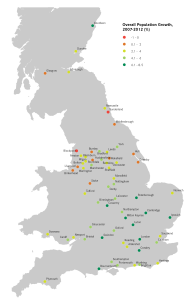Between 2007 and 2012, population growth was highest in cities in the Greater South East. In England and Wales, this growth was mainly driven by natural increases (births minus deaths) while in Scotland, it was driven by migration.
Yesterday, we published a blog looking at internal, international and net migration flows to UK cities in the last five years. Using the same ONS data, this blog looks at population growth for the same period and the role of migration in driving that growth.
Numbers show that UK cities are growing. Despite accounting for only 9 per cent of the landmass, they accounted for 65 per cent of the national population growth between 2007 and 2012. However, not all cities are growing at the same rate, and the sources of this growth also vary – between internal and internal migration or natural growth (total births minus deaths). Below are maps showing the results in addition to 5 trends worth highlighting:
- Most of the population growth between 2007 and 2012 took place in cities in the Greater South East. Milton Keynes saw the highest increase (8.5 per cent) followed by Luton (7.8 per cent), Cambridge (7.75 per cent), Peterborough (7.5 per cent) and London (7 per cent).
- Sunderland and Blackpool were the only two cities that lost population in that period (-0.5 per cent and -0.8 per cent respectively) and northern cities saw small gains in general.
- In England and Wales, two third of cities rely on natural growth for the increase in their population. Most notably, more than 90 per cent of population growth in Birmingham, Cambridge, Liverpool and Leicester comes from natural increases.
- The reliance on natural increase in population is mainly apparent in medium and small cities in England and Wales. In Milton Keynes and Peterborough, more than 60 percent of population growth was due to natural increase while in Cambridge, Leicester and Blackburn for example, natural growth accounted for more than 90 percent.
- Large cities in England and Wales show a mixed picture. 95 percent of population in Birmingham is due to natural increases, and this goes down to 65 per cent in London and around 50 percent in Leeds, Nottingham and Sheffield.
- In Scottish cities, migration has been the main driver of population growth since 2007. In Dundee, Aberdeen and Glasgow, around 70 per cent of this growth is due to migration and in Edinburgh, large inflows of migrants are more than offsetting the natural decrease in population (3 per cent increase overall).


Leave a comment
Be the first to add a comment.